
The whiskered myiobius or bearded flycatcher is a species of bird in the family Tityridae, having previously been included in Tyrannidae. A number of taxonomic authorities continue to place with the flycatchers. The whiskered myiobius is found in Brazil, Colombia, Ecuador, French Guiana, Guyana, Peru, Suriname, and Venezuela. Its natural habitats are subtropical or tropical moist lowland forests and heavily degraded former forest.
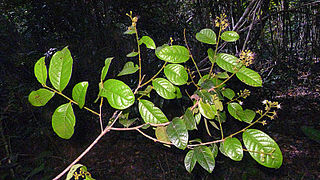
Hirtella is a genus of 110 species of woody trees in family Chrysobalanaceae. It was first described as a genus by Linnaeus in 1753. Hirtella naturally occurs in tropical forests throughout Latin America, the West Indies, southeast Africa, and Madagascar. The flowers are mainly pollinated by butterflies.

Eugène Le Moult was a French naturalist and entomologist specialised in butterflies; hunter, businessman and collector.

Morpho achilles, the Achilles morpho, blue-banded morpho, or banded blue morpho, is a Neotropical butterfly.

Morpho deidamia, the Deidamia morpho, is a Neotropical butterfly. It is found in Panama, Nicaragua, Costa Rica, Suriname, Bolivia, Venezuela, Colombia, Peru, Ecuador, and Brazil. It is a species group, which may be, or may not be several species. Many subspecies have been described.

Morpho adonis, the Adonis morpho, is a Neotropical butterfly. It is found in Venezuela, Suriname, French Guiana, Colombia, Ecuador, Brazil, and Peru. The wingspan ranges from 70 to 90 millimetres.

Morpho rhetenor, the Rhetenor blue morpho, is a Neotropical butterfly of the family Nymphalidae. It is found in Suriname, French Guiana, Brazil, Peru, Ecuador, Colombia, and Venezuela.

Ateuchus is a genus of some 100 species of New World scarab beetles (Scarabaeidae) in the subfamily Scarabaeinae. They are found mainly in the Neotropics.

Amarynthis is a monotypic genus of butterflies in the family Riodinidae. Its sole species, Amarynthis meneria, the meneria metalmark, is a common species in lowland rainforests east of the Andes from Venezuela, Suriname and Guyana, south through the Brazilian Amazon to Peru and northern Argentina.

Nessaea obrinus, the obrina olivewing, is a species of butterfly of the family Nymphalidae. It is found from Colombia and the Guianas to the mouth of the Amazon and south to central Bolivia and Mato Grosso in Brazil, extending to northern Argentina.

Marpesia is a butterfly genus in the family Nymphalidae. The species of this genus are found in the Neotropical and Nearctic realms.
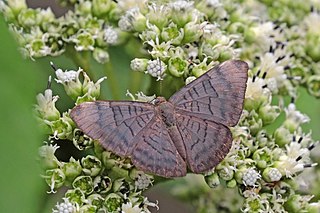
Emesis lucinda is a butterfly of the family Riodinidae. It is found from Mexico to Bolivia and in Suriname, French Guiana and Brazil.

Eryphanis automedon, the Automedon giant owl, is a species of butterfly belonging to the family Nymphalidae.

Lyropteryx apollonia, the Apollo metalmark, pink-dotted metalmark or blue-rayed metalmark, is a butterfly of the family Riodinidae, subfamily Riodininae, tribe Riodinini. The species was first described by John O. Westwood in 1851.

Alesa is a New World genus of metalmark butterflies found in northern South America.

Mimoides pausanias, the Pausanias swallowtail or bluish mimic-swallowtail, is a species of butterfly in the family Papilionidae.

Morpho telemachus is a Neotropical butterfly.
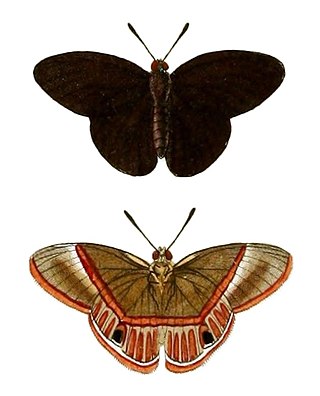
Euselasia is a genus of butterflies in the family Riodinidae. They are present only in the Neotropical realm. The genus was erected by Jacob Hübner in 1819.
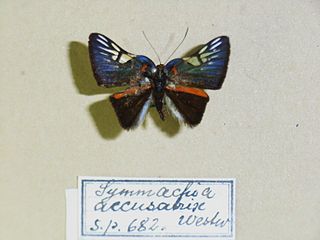
Symmachia is a genus in the butterfly family Riodinidae present only in the Neotropical realm.
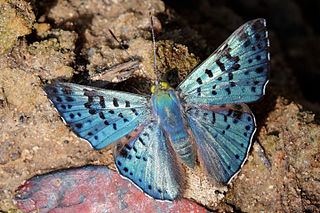
Lasaia agesilas, the glittering sapphire, black-patch bluemark or Narses metalmark is a metalmark butterfly. The species was first described by Pierre André Latreille in 1809. It is native to Central America and the north of South America. It ranges from Costa Rica, Panama, Venezuela, Trinidad, Colombia, Ecuador, Peru, Bolivia, Guyana, Argentina, to the Brazilian Amazon.




















